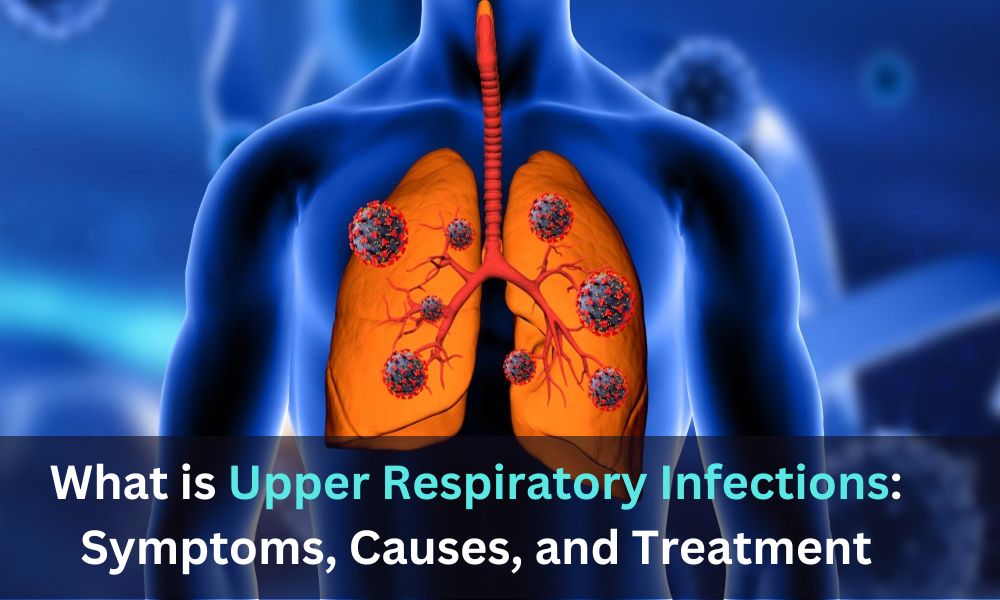January 21, 2024
What is Upper Respiratory Infections: Symptoms, Causes and Treatment

What is Upper Respiratory Infections?
Upper respiratory infections (URIs) are a group of illnesses that affect the upper respiratory tract, including the nose, sinuses, throat, and larynx. Common examples of URIs include the common cold, flu (influenza), sinusitis, and pharyngitis (sore throat). These infections are often caused by viruses.
The autumn season brings several ongoing changes with it; some are pleasant while others seem unpleasant. The upper respiratory infection is another common type that is usually known by everyone. Even though these infections are usually not very severe, they can still reduce the enjoyment of the fall and winter evenings. To overcome these obstacles, there must be good know-how of what causes and what possible ways exist to treat this infection.
Symptoms of upper respiratory infection
When someone is infected due to a respiratory virus, their body starts showing certain symptoms which might be that hard to tolerate. When there’s something wrong and you’re about to get sick, the first sign is usually a rough throat followed by a congested throat. Such reactions typically include sneezing, elevated body temperatures, and coughing fits followed by a feeling of becoming unhealthy. Even though the fever happens occasionally, it can also develop in kids.
Coughing: Persistent cough, often accompanied by phlegm or mucus.
Sneezing: Frequent sneezing, especially at the onset of the infection.
Nasal Congestion: Stuffy or runny nose, with mucus production.
Sore Throat: Irritation or pain in the throat, making swallowing uncomfortable.
Headache: Mild to moderate headaches may occur.
Fever: Some URIs, particularly those caused by viruses, can be associated with a low-grade fever.
Fatigue: Feeling tired and lacking energy is common.
Body Aches: Generalized muscle aches or discomfort may be present.
Watery Eyes: Irritation and tearing of the eyes may occur.
Severity and Duration
Generally, the symptoms of a respiratory infection can last for a couple of days Ultimately, two weeks has been specified for completing this course. People’s responses to infection are different. Some have light signs and symptoms while others bear heavy ones such as insomnia, and high fever. How intense the symptoms are going to be and for how long they will last is very reliant on a person’s overall health and their immune system’s status.
What are the Causes of Infection in Upper Respiratory Tract?
Upper respiratory tract infections are mainly caused by the rhinovirus since this type of virus is very powerful. Viruses can travel through the droplets formed by talking, coughing, or sneezing with each other. This is why many scientists suggest maintaining a social distance.
Another way that this virus can spread is by touching the infected surfaces first and then our face. The mucosal lining of the nose, mouth, and eyes are the main entries for this virus to infect us. These small invaders trigger the body cells to resist and replicate.
Environmental aspects too have an impact. Inhaling the dry air during winter can reduce the immunity of the mucus membranes in the nose. It thus makes it more vulnerable to airborne pathogens. On the flip side, increasing time indoors automatically spikes the acquisition of these diseases during cooler months. The tiredness because of stress can also cause the weakening of the body’s defence system, making it more prone to infections.
Treatment: Alleviating the Symptoms
Although Upper respiratory infection is irremovable, there are still several ways to reduce its symptoms.
Running nose and nasal congestion can be relieved by incorporating antihistamines into one’s health regimen. Pain can easily be managed by the intake of acetaminophen or ibuprofen.
Both lifestyle changes and home remedies are valuable for improved health. Drinking water and hot beverages can improve the breathing system by clearing out the throat passageway.
When the air is dry, the nasal congestion can be quite problematic. This particular trouble can be mitigated by humidifiers. These humidifiers can help in increasing the moisture content of the air leading to watery nasal secretion pathways and relief from dryness.
For a body to fight infections well, it needs good times of rest.
When to Seek Medical Attention?
If the symptoms (fever, cough, or breathlessness) exist beyond 2 weeks, consult a healthcare provider right away. In the case of some specific viral respiratory infection cases, they might require antibiotic therapy to be managed because they are complicated by bacterial infections. When it comes to the health history of a person, and symptoms they are showing. Medical professionals can offer the best advice against it.
Prevention is Essential:
There are a variety of common practices that can help in decreasing the risk of contracting an upper respiratory infection as follows:
-
The Power of Hygiene
To prevent upper respiratory tract infections, one needs to focus on good personal hygiene. Viruses spreading through sneezing or coughing can be minimized if washing their hands becomes a habit of routine life. It’s also very important to cover your mouth while you cough and avoid interaction with the people already infected.
-
Boosting Immunity
It is known that having a healthy lifestyle strengthens your immune system. The risk of infections is reduced to some extent through intake of certain fruits and vegetables. It will also get reduced with the intake of a limited amount of workout, and a maintained sleeping cycle can lead to lowering. Some viruses can be best fought off if a person is vaccinated even against the flu.
Conclusion: Embracing Awareness and Action
While upper respiratory infection is not a very severe form of illness, they will thwart people’s excitement for the autumn and winter seasons. This yearning will help individuals to handle such situations smartly and safeguard their health. One can reduce the severity of URIs and have a good time during festive months by taking proper care early.




